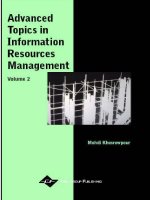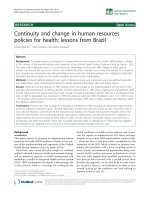HRM 5th chapter 3 equity and diversity in human resources management
Bạn đang xem bản rút gọn của tài liệu. Xem và tải ngay bản đầy đủ của tài liệu tại đây (1.04 MB, 32 trang )
Equity and Diversity in
Human Resources
Management
Managing Human Resources
Belcourt * Bohlander * Snell
© 2008 by Nelson, a division of Thomson Canada
Limited.
All rights reserved.
5th Canadian edition
PowerPoint Presentation by Monica Belcourt, York University
and Charlie Cook, The University of West Alabama
Objectives
After studying this chapter, you should be able to:
1.
Explain the reasons for employment equity legislation.
2.
Identify and describe the major laws affecting employment
equity and explain how they are enforced.
3.
Describe pay equity and strategies for implementing it.
4.
Describe the Employment Equity Act with respect to its
origins, its purpose and its continued enforcement.
5.
Describe how employment equity is implemented in
organizations.
6.
Discuss sexual harassment as an employment equity issue.
7.
Explain and give examples of diversity management.
Copyright © 2008 by Nelson, a
division of Thomson Canada
Ltd.
3–2
Employment Equity
• The employment of
individuals in a fair and
nonbiased manner
Copyright © 2008 by Nelson, a
division of Thomson Canada
Ltd.
3–3
Government Regulation of EE
• Designated Groups
Women, visible minorities, aboriginal peoples and
persons with disabilities who have been
disadvantaged in employment.
Copyright © 2008 by Nelson, a
division of Thomson Canada
Ltd.
3–4
Representation of Designated Groups in the Labour Force
Copyright © 2008 by Nelson, a
division of Thomson Canada
Ltd.
Source: Statistics Canada website: www.statcan.ca/english/PGDB/labour20a.htm, table 282-0002.
Figure 3.1
3–5
Benefits of Employment Equity
• Larger applicant pool
• Avoid costly human rights complaints
• Enhanced ability to recruit and retain
• Enhanced employee morale
• Improved corporate image
Copyright © 2008 by Nelson, a
division of Thomson Canada
Ltd.
3–6
The Legal Framework
• The Charter of Rights and
Freedoms
• Canadian Human Rights
Act
Copyright © 2008 by Nelson, a
division of Thomson Canada
Ltd.
3–7
Bona fide occupational qualification
• A justifiable reason for
discrimination based on
business reasons of
safety or effectiveness.
Copyright © 2008 by Nelson, a
division of Thomson Canada
Ltd.
3–8
Enforcement of the CHRA
• Complainant completes a written report.
• A CHRC representative reviews the facts.
• If the complaint is accepted, an investigator is
assigned and gathers more facts.
• A report is submitted recommending
substantiation or non-substantiation of the
allegation.
• If the complaint is substantiated, parties may
reach settlement or a human rights tribunal may
be appointed to further investigate and
determine
settlement.
Copyright
© 2008
by Nelson, a
division of Thomson Canada
Ltd.
3–9
Pay Equity
• Equal pay for work of
equal value
• Equal pay for work of
comparable worth
Copyright © 2008 by Nelson, a
division of Thomson Canada
Ltd.
3–10
Employment Equity Act -- Employer Duties
• Provide a self identification form.
• Identify jobs where members of designated
groups are under-represented.
• Communicate information on employment equity
to its employees and consult and collaborate
with employee representatives.
• Identify possible barriers in existing employment
systems that may be limiting the employment
opportunities of members of designated groups.
Copyright © 2008 by Nelson, a
division of Thomson Canada
Ltd.
3–11
Employer duties (con’t)
• Develop an employment equity plan aimed at
promoting an equitable workforce.
• Make all reasonable attempts to implement this
plan.
• Monitor, review and revise the plan from time to
time.
• Prepare an annual report on its employment
equity data and activities.
Copyright © 2008 by Nelson, a
division of Thomson Canada
Ltd.
3–12
Employment Equity Act
• Administered by HRDC
• Prohibits discrimination in federally regulated
businesses
• Failure to comply may result in fines
Copyright © 2008 by Nelson, a
division of Thomson Canada
Ltd.
3–13
Implementation of EE in organizations
1. Senior management commitment
2. Data collection and analysis
3. Employment systems review
4. Establishment of a work plan
5. Implementation
6. Evaluation, monitoring and revision
Copyright © 2008 by Nelson, a
division of Thomson Canada
Ltd.
3–14
Step 1: Senior Management Commitment
• Top down strategy
• Policy statements
• Communication tools
• Assignment of responsible senior staff
• Consult with members of designated groups
and/or bargaining agents in unionized settings
Copyright © 2008 by Nelson, a
division of Thomson Canada
Ltd.
3–15
Step 2: Data Collection
• Stock data
The number, titles, salaries, etc. of members of
designated groups in the organization.
• Flow data
The distribution of members of designated groups in
applications, interviews, hiring decisions, training and
promotion opportunities and terminations.
Copyright © 2008 by Nelson, a
division of Thomson Canada
Ltd.
3–16
Self identification form should contain
• The employment equity policy
• A statement that the form will be confidential
• Categories for self identification with brief
explanations and examples
• An indication that the form has been reviewed by
the relevant human rights agency
• Spaces for comments and suggestions
• The name of the contact person
Copyright © 2008 by Nelson, a
division of Thomson Canada
Ltd.
3–17
Workforce Utilization Analysis
• Workforce Utilization Analysis
The process of comparing the composition of
members of designated groups within an organization
against composition of the employer’s relevant labour
market.
Underutilization: term applied to designated groups
that are not utilized or represented in the employer’s
workforce proportional to their numbers in the labour
market.
Concentration: term applied to designated groups
whose numbers in a particular occupation are high
relative
to their
numbers
Copyright
© 2008
by Nelson,
a in the labour market.
division of Thomson Canada
Ltd.
3–18
Step 3: Employment Systems Review
• Systemic discrimination
The exclusion of members of certain groups through
the application of employment policies or practices
based on criteria that are not job-related.
• Reasonable accommodation
Attempt by employers to adjust the working conditions
or schedules of employees with disabilities or
religious preferences.
Copyright © 2008 by Nelson, a
division of Thomson Canada
Ltd.
3–19
Suggestions for an Accessible Workplace
• Install easy-to-reach switches.
• Provide sloping sidewalks and
entrances.
• Install wheelchair ramps.
• Reposition shelves for the easy reach
of materials.
• Rearrange tables, chairs, vending
machines, dispensers, and other
furniture and fixtures.
• Widen doors and hallways.
• Add raised markings on control
buttons.
• Provide designated accessible parking
spaces.
• Install hand controls or manipulation
devices.
• Provide flashing alarm lights.
• Remove turnstiles and revolving doors
or provide alternative accessible paths.
• Install holding bars in toilet areas.
• Redesign toilet partitions to increase
access space.
• Add paper cup dispensers at water
fountains.
• Replace high-pile, low-density
carpeting.
• Reposition telephones, water fountains,
and other needed equipment.
• Add raised toilet seats.
• Provide a full-length bathroom mirror.
Source: Statistics Canada website:
www.statcan.ca/english/Pgdb/labor20a.htm, table 282-0002.
Copyright © 2008 by Nelson, a
division of Thomson Canada
Ltd.
Figure 3.4
3–20
Step 4: Establishment of a Workplan
• The data analysis would have revealed gaps in
underutilization.
• Based on these, goals and timetables can be
established, subject to restrictions due to
collective agreements, etc.
• The plan should include numerical goals,
timetables, explanations about the proposed
improvements in the hiring, training and
promotion of designated groups to increase their
representation and distribution throughout the
organization.
Copyright © 2008 by Nelson, a
division of Thomson Canada
Ltd.
3–21
Establishment of a workplan (con’t)
• Descriptions of specific activities to achieve the
numerical goals.
• An outline of monitoring and evaluation
procedures to follow program implementation.
Copyright © 2008 by Nelson, a
division of Thomson Canada
Ltd.
3–22
Step 5: Implementation
• No two implementation plans will be the same.
• May be modified as circumstances change.
Copyright © 2008 by Nelson, a
division of Thomson Canada
Ltd.
3–23
Step 6: Evaluation, Monitoring and Revision
• Need annual progress
reports
• Interim reports on special
projects
Copyright © 2008 by Nelson, a
division of Thomson Canada
Ltd.
3–24
Sexual Harassment
• Sexual Harassment
Unwelcome advances, requests for sexual favours,
and other verbal or physical conduct of a sexual
nature in the working environment.
Copyright © 2008 by Nelson, a
division of Thomson Canada
Ltd.
3–25









